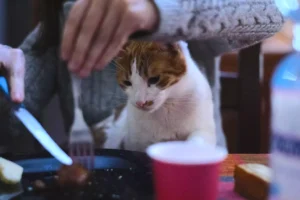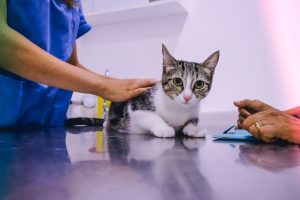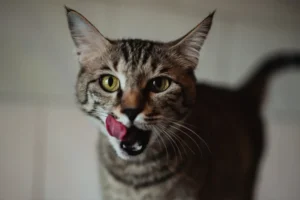Note: We may earn a commission from helpful, relevant links in our content. No cost to you. See our privacy policy.
We all love pampering our furry friends, but when it comes to treating our cats, making the right choice is crucial for their health. Temptations cat treats are a popular option, but are they truly a safe choice?
Discover the factors that determine a treat’s impact on your cat’s well-being and learn how to make smart decisions when treating your feline companion.

Are Temptations Cat Treats Harmful to Cats?
Temptations cat treats, when fed in moderation, are generally safe for cats. However, they should not replace a balanced, species-appropriate diet.
These treats are intended as occasional rewards or indulgences and should not be a staple in your cat’s daily nutrition.
By limiting the number of treats and ensuring your cat receives a well-rounded diet, you can minimize the risk of any potential health issues.
Ingredients of Temptations Cat Treats
Here’s a table of some key ingredients found in Temptations cat treats. Keep in mind that this is not an exhaustive list, and specific ingredients may vary depending on the flavor or variety of the treat. Always refer to the packaging for complete ingredient information.
| Ingredient | Purpose |
|---|---|
| Chicken by-product meal | Protein source |
| Ground corn | Carbohydrate source, binding agent |
| Animal fat | Source of energy, improves palatability |
| Dried meat by-products | Protein source |
| Brewers rice | Carbohydrate source |
| Wheat flour | Carbohydrate source, binding agent |
| Natural flavors | Enhances taste |
| Corn gluten meal | Protein source |
| Potassium chloride | Electrolyte, maintains proper hydration and fluid balance |
| Choline chloride | Essential nutrient for nerve function and liver health |
| Calcium carbonate | Source of calcium, supports bone and dental health |
| Taurine | Essential amino acid for heart health and vision |
| Vitamins (e.g. Vitamin E) | Supports overall health and immune function |
| Minerals (e.g. Zinc) | Supports various bodily functions, including immune response |
This list includes both nutritious and less-desirable ingredients. You should always read the label and research the ingredients by yourself to ensure you are providing the best treat options for your cat.
From this table, we can conclude that while Temptations cat treats contain some beneficial ingredients, they also include less-desirable components such as by-products and grains.
Therefore, excessive consumption or reliance on them as a primary food source may lead to potential health issues, discussed below. It’s crucial to balance treat intake with a nutritionally complete diet and opt for healthier treat alternatives when possible.
Can Feeding Too Many Treats Cause Health Issues?
Absolutely, feeding too many treats to your cat can lead to health issues. In this section, we will explore the potential problems that may arise from overindulging your feline friend in treats and how to avoid them.
Weight Gain and Obesity
One of the most common issues resulting from excessive treat consumption is weight gain, which can lead to obesity. Obesity in cats is linked to several health problems, including diabetes, arthritis, and liver disease.
Nutritional Imbalance
Just like underfeeding a cat can lead to health issues, feeding your cat too many treats can also lead to a nutritional imbalance.
Treats are not formulated to provide all the essential nutrients your cat needs, and relying on them as a primary food source can result in deficiencies or imbalances.
Dental Issues
Treats, especially those high in sugar or carbohydrates, can contribute to dental issues such as plaque buildup and tooth decay. It’s essential to choose treats that promote dental health and provide proper dental care for your cat.
What Makes a Cat Treat Healthy or Unhealthy?
A healthy cat treat typically contains high-quality protein sources, essential nutrients, and minimal artificial additives or preservatives. Unhealthy treats, on the other hand, may be high in calories, carbohydrates, and contain artificial flavors or colors.
When choosing treats for your cat, check the ingredient list and opt for those with natural, wholesome ingredients to ensure your cat enjoys a tasty and nutritious treat.
Alternatives to Temptations Cat Treats
If you’re looking for healthier alternatives to Temptations cat treats, consider the following options that prioritize your cat’s well-being without compromising on taste.
Freeze-Dried Treats
Freeze-dried treats are made from a single protein source, such as chicken, salmon, or beef, and are preserved without any additives or artificial ingredients. These treats are both nutritious and delicious for your cat.
Dental Treats
Dental treats help maintain your cat’s oral health by reducing plaque and tartar buildup.
Look for treats with a texture that promotes chewing and has a VOHC (Veterinary Oral Health Council) seal of approval.
Homemade Treats
Making homemade treats allows you to control the ingredients and ensure they are both healthy and tailored to your cat’s preferences.
Experiment with recipes using high-quality protein sources and minimal additives, and you’re sure to discover lots of recipes for your purring pal.
Suggested read: Homemade Cat Diet Guide
Tips for Avoiding Health Issues from Treats
To ensure your cat enjoys the benefits of treats without potential drawbacks, consider the following recommendations:
- Monitor treat intake. Treats should make up no more than 10% of your cat’s daily caloric intake. Monitor the number of treats given to prevent overindulgence.
- Choose healthier options. Opt for treats that are low in calories, carbohydrates, and artificial additives, and high in protein and essential nutrients.
- Encourage exercise. Engage your cat in regular play sessions to help maintain a healthy weight and burn off any extra calories from treats.
- Establish a routine. Create a routine for giving treats, such as during playtime, grooming, or training. This helps your cat associate treats with positive experiences and prevents them from expecting treats at random times.
- Use treats for positive reinforcement. Utilize treats as a reward for good behavior or during training sessions. This approach strengthens the bond between you and your cat and encourages desirable behaviors.
By keeping these points in mind, you can indulge your cat with treats while ensuring their overall health and well-being.
I remember when I tried to transition my cat to a healthier treat option. I had no idea how to do it and I wasn’t sure how he would react. I just randomly started giving him freeze-dried chicken treats during our play sessions, and to my surprise, he loved them!
Now, Captain Fluffington gets excited every time I reach for the treat jar, and I feel confident knowing I’m offering him a healthier alternative.
FAQS
How many Temptations treats can I give my cat per day?
Krista Williams and Robin Downing (DVMs) from VCA Hospitals, suggest that treats should make up no more than 10% of your cat’s daily caloric intake. This usually equates to around 10-15 Temptations treats per day, depending on your cat’s size and activity level.
Are there any specific ingredients in Temptations that are harmful to cats?
While Temptations treats aren’t necessarily harmful, they may contain artificial additives, flavors, or colors that could potentially cause sensitivities or allergic reactions in some cats.
Can my cat become addicted to Temptations treats?
Cats can develop strong preferences for certain treats like Temptations due to their enticing taste and texture, but “addiction” is not a scientifically accurate term for this behavior.
How can I introduce new, healthier treats to my cat?
Introduce healthier treats gradually by offering them alongside your cat’s favorite Temptations treats, and slowly reduce the number of Temptations while increasing the healthier options until your cat accepts the new treats.
Alex, a passionate animal lover, has experience in training and understanding animal behavior. As a proud pet parent to two dogs and three cats, he founded AnimalReport.net to share insights from animal experts and expand his knowledge of the animal kingdom.









